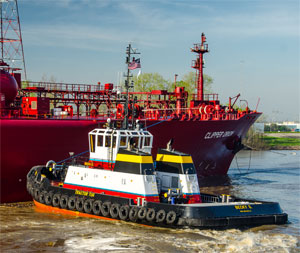Bisso Towboat is celebrating its 125th anniversary in business with the delivery of Becky S., the fifth z-drive tug in the company’s New Orleans fleet. “Every time we come out with one I’m like a kid in a candy store,” said Scott Slatten, president of the company.
Becky S. is named for the wife of Scott Slatten. Slatten’s ancestry reaches back to the formation of the company by Captain Joseph Bisso in 1890. This year’s anniversary marks Bisso Towboat as the oldest tugboat company on the Mississippi River.
Built at Main Iron Works of Houma, La., the new tug was delivered in mid-March. With the river rising due to a big freshet running south from the upper half of the country, Becky S. was put to work immediately, holding in ships and combatting the swollen river’s aggressive current. “The river is picking up and high water means fast water, and that will make it interesting for us,” said Jon Davis, the company’s safety and quality manager.
Becky S. is a gleaming example of the high level of craftsmanship employed by Main Iron Works, designer and builder of nine tugs for Bisso in the past 23 years. The tug’s pilothouse, finished in glistening Spanish cedar and surrounded by abundant glass, is a signature of the yard’s approach to quality finishing, widely recognized throughout the industry.
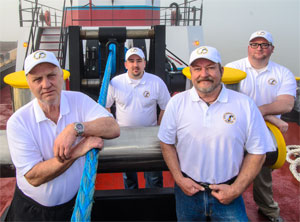 |
|
From left, chief engineer George Burke, mate Trent Taylor, Capt. Steve Williams and deck hand Jason Branch on the deck of Becky S. |
“This is a luxury boat,” said Capt. Steve Williams, at the helm of Becky S. as the tug assisted the 673-foot tanker Clipper Orion on the tug’s second week on the river. “You look at the woodwork and the quality of the finishing. They are beautiful tugs.”
In 1999, Main Iron built the 100-by 38-foot Cecilia B. Slatten for the Bisso Towboat fleet. It was the first z-drive tug on the river, followed by Alma S., Michael S., William S. and now Becky S.
All five tugs are practically identical in design, but Williams pointed out that there are subtle changes, such as adding more defroster vents and placing them a little higher to better clear the windows. There have also been propulsion and deck equipment changes but, in dimensions and profile, the tugs are alike.
“I’m the senior captain in the company,” said Williams. “I started at Bisso on August 15, 1977, the day before Elvis died. Hard to believe he died 37 years ago. I love the maneuverability and the power of this boat, the handling and the quick response. I can go anywhere on a ship and it can get you out of trouble fast.”
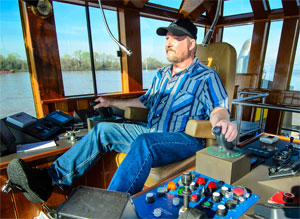 |
|
Williams at the controls. The tug’s pilothouse is finished in glistening Spanish cedar and has an excellent all-around view. |
Be that as it may, from the crew’s point of view the most exciting upgrade seems to be the addition of a second head, lending credence to the cliché that two heads are better than one.
Next in succession of popularity was the addition of a 6-foot mudroom located aft of the galley, between the stacks. The change allowed for moving the engine room door from the galley to the mudroom, greatly reducing the noise in the crew quarters.
Stepping up to Tier 3 emission controls on Becky S. produced an unexpected bonus over and above the obvious benefit to the environment. The twin Caterpillar 3516 T3MPL mains generate 4,480 hp, a 480-hp increase over the 4,000-hp, Tier-2 Caterpillar mains on Michael S. and William S. tugs at 1,652 rpm. “They say that there is a 10 percent increase in horsepower and a 10 percent decrease in fuel consumption,” said Slatten.
When Bisso changed from 16-cylinder EMDs on Cecilia B. Slatten and Alma S. to Caterpillar engines on Michael S. in 2010, it got another bonus — a lot more space in the engine room. The company’s senior engineer, George Burke, has also been with the company for 37 years. He didn’t mention Elvis, but he applauded the abundant room in the tug. “It’s amazing. Everything is accessible in the engine room. And all the connections for hoses, fuel, water and oil discharge are accessible outside the engine room, so there’s no dragging hoses around in here.”
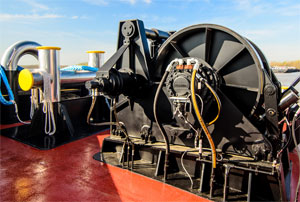 |
|
A stainless-steel H-bitt, supplied by Washington Chain & Supply, on the stern. |
The mains power two Rolls-Royce US 205 FP azimuthing stern drives with 90.6-inch diameter by 82.4-inch pitch, four-blade stainless-steel propellers in stainless-steel nozzles. The package produces 60 tons of bollard pull and 12 knots of speed.
The two 99-kW Marathon generators are powered by John Deere 4045A FM85 Tier 3 diesels.
During a steamy Southern summer, air conditioning can lose the race with the heat index. The unrelenting rays of a Louisiana sun, beating down on HVAC compressors, typically mounted aft of the pilothouse on a broiling bridge deck, tax the units to the maximum. On William S. and Becky S., Bisso adopted a keel-cooled air conditioning system.
“It’s extremely efficient,” said Davis. “The forced air is constantly being cooled by the river water.” Davis reported that it is not only more comfortable in the tug, but the company is saving money on maintenance costs.
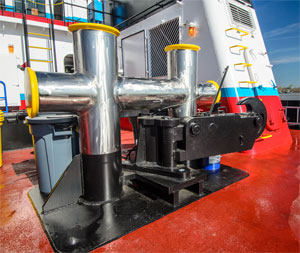 |
|
Main Iron Works added an aluminum grill ahead of the H-bitt between the stacks. |
Bisso also reconfigured the duct work for the engine room blowers on Becky S., installing a curved port duct that directs the air forward, combined with a perpendicular starboard intake duct that creates a draft all the way forward.
On deck, the big change is the towing winch. The four previous ASD tugs are equipped with Markey hawser winches. Becky S. is fitted with a JonRie Series 230 hydraulic, auto-tensioning hawser winch with 500 feet of Samson 8-inch Amsteel Blue line. According to Slatten, all things being equal, the change realizes a significant cost saving and JonRie’s service is within driving distance at Moss Point, Miss.
The latest version of the JonRie 230 winch has a larger drum, allowing for more 8-inch hawser line. The brake is rated at 300 tons, the line pull is 15 tons and the line speed is 100 fpm. JonRie’s active heave compensation system allows the winch to pay out at a high speed in a controlled free-wheel mode to help the tug maneuver in the strong Mississippi currents.
Standard equipment on a Bisso Towboat bow is a stainless-steel H-bitt and a stainless-steel staple on the bow stem. Also standard equipment on the stern of the company’s ASD tugs is a Washington Chain & Supply RSRH-100 100-ton capacity tow hook, and a stainless-steel H-bitt. Main Iron Works added an aluminum grill ahead of the H-bitt between the stacks. “They build one onto all of their newbuild tugs,” said Davis.
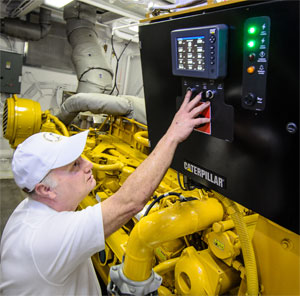 |
|
Chief engineer George Burke at the engine control panel. Propulsion is provided by two Caterpillar 3516 Tier 3 mains. |
As with Becky’s predecessors, M&M Bumper custom-designed and fabricated the fendering. “We build it by hand,” said Robyn Gonsoulin, president of the Bourg, La., company. “The 22-inch-thick bow fender, combined with the bulwarks and the hull fender, is constructed as an all-in-one unit. Building a fender this way is not an easy task. The bow fender alone uses 892 truck tires and weighs in at over 20,000 pounds.”
M&M also fabricated a 24-by-11-inch-thick laminated stern fender. The rubber for Becky S. is trimmed by hand to fit the vessel, and the 42 recycled aircraft tires are pre-rigged with galvanized steel chain and shackles to save man hours at the shipyard.
“We are really excited about the new boat. It never gets old,” said Slatten. He added that the company is committed to z-drives because they have proven themselves admirably suited to the job of ship-assist work in tight spots and difficult currents. “And they are also adept at chewing up the debris that populates the lower Mississippi River. The drives are not as vulnerable to jamming and breakage from logs and flotsam as was first thought.”
Bisso Towboat is in negotiations with Main Iron Works for another tug, the goal being to have the keel laid before Tier 4 emission standards change the way tugs are built. “We’re gathering some pricing,” said Slatten. “Main Iron Works would be our preference. They’ve built nine for us in the last 23 years and their craftsmanship is second to none.”
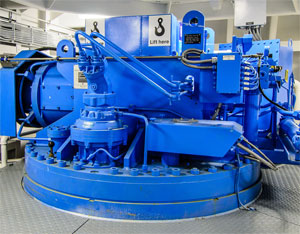 |
|
Rolls-Royce US 205 azimuthing stern drives are linked to 90-inch stainless-steel props. |
Main Iron Works has suffered some dramatic losses this past couple of years with the passing of first LeRoy Molaison and then, quite suddenly, his son Doug. Cenac Towing bought the yard and is folding it into its Houma operation. Before the acquisition, Main Iron Works built hulls and superstructures for Cenac’s tugs and then Cenac completed them at its own yard. So, the transition should be smooth.
“Now that Benny Cenac owns the boatyard, they shouldn’t skip a beat because Benny’s boats are first-class and they should be able to build to the same quality with all of the same people working at Main,” said Slatten.
There are now 14 ASD tugs operating from the mouth of the Mississippi River to Baton Rouge. Bisso Towboat leads the count with five; E.N. Bisso & Son is next with four and another under construction at Eastern Shipbuilding. Crescent Towing has three z-drives with two more under construction at Steiner Shipyard in Bayou La Batre. Moran, a latecomer to the river, has two.
Cargo, comfort and craftsmanship aside, for Williams, Becky S. is, at heart, a workboat. “Jobwise, it’s the maneuverability of the boat that captivates you. It’s a blast to run. It has rekindled my love for the river, rekindled my love for the job. It’s opened up new doors to learning new things, even at my age.”

